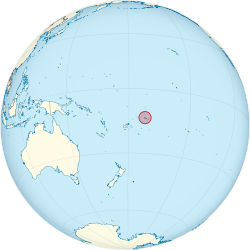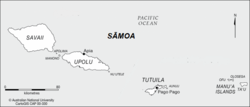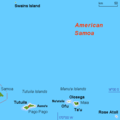
The first inhabitants of Tuvalu were Polynesians, so the origins of the people of Tuvalu can be traced to the spread of humans out of Southeast Asia, from Taiwan, via Melanesia and across the Pacific islands of Polynesia.
Nukufetau Airfield is a former World War II airfield on the south-eastern side of Nukufetau on Motulalo Island in Tuvalu during the Pacific War.

Nanumea Airfield is a former World War II airfield on the island of Nanumea in the Ellice Islands.
The 7th Antiaircraft Artillery Battalion was a United States Marine Corps antiaircraft unit that served during World War II. Formed in 1940 as the 7th Defense Battalion, its original mission was to provide air and coastal defense for advanced naval bases. It was one of first five defense battalions deployed in support of the color-coded war plans that called for the defense of Hawaii and other outlying United States possessions in the Pacific Ocean. These five battalions were nicknamed the "Rainbow Five." During the war the battalion defended Tutuila, Upolu, Savai'i and Nanumea and took part in combat operations at Anguar. The 7th was decommissioned before the end of World War II on 2 August 1945.
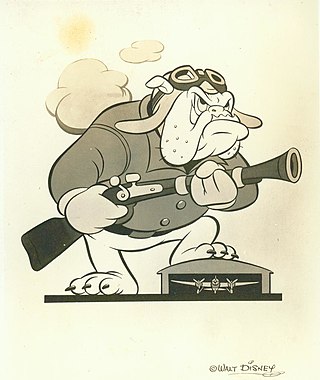
The 17th Antiaircraft Artillery Battalion was an antiaircraft unit in the United States Marine Corps that served during World War II. The battalion was originally formed in 1942 as the 2d Airdrome Battalion and has the distinction of being the last defense battalion formed in the Marine Corps during the war. Its original mission was to provide air and coastal defense for advanced naval bases. During the war the battalion spent significant time defending Nukufetau and took part in combat operations at Tarawa and Tinian. The battalion was decommissioned on December 6, 1945.

US Naval Advance Bases were built globally by the United States Navy during World War II to support and project U.S. naval operations worldwide. A few were built on Allied soil, but most were captured enemy facilities or completely new. Advance bases provided the fleet with support to keep ships tactically available with repair and supply depots of facilities, rather than return them to the continental United States. Before Japan declared war on the United States the U.S. Navy had a single fleet-sized advanced base in the Territory of Hawaii at Naval Station Pearl Harbor. During the war the U.S. Navy Seabees built over 400 advance bases categorized by size. Naval bases were either Lions or Cubs while airfields were either Oaks or Acorns. Lions and Oaks were major facilities while Cubs and Acorns were minor. PT Boats typically would get a Cub and airfields with single runways were Acorns. The larger bases could provide refueling and overhaul; loading of troopship and cargo ships; and preparing amphibious assault ships. Some became major repair depots. The Seabees developed auxiliary floating drydocks were able to repair battle damage and do regular maintenance in the field saving ships trans-pacific trips for repair. A few bases also were developed to be R and R for all U.S. personnel. Most Advance Bases were built by the US Navy's Seabees in Naval Construction Battalions (CBs). At the start of the war civilian contractors were employed in construction. The Seabees in World War II built most of the airfields used by the United States Army Air Forces and United States Marine Corps, as they had the ships and cranes needed to transport the vast amount of equipment needed at the advance bases. The US Army and United States Coast Guard also operated out of many of these facilities. Seabees could build new or repair damaged runways, and with advancements in heavy bomber technology lengthen runways as needed. A few Naval Advance Bases were built for the Korean War and Vietnam War.

Naval Base Noumea was a major United States Navy sea and air base at Nouméa, New Caledonia. Naval Base Noumea was built at Noumea Harbor. Noumea was picked for a naval base as it was beyond the range of Japanese land-based planes. Noumea is on the east side of the Coral Sea, 1,469 kilometres from Brisbane, Australia. The base was built during World War II to support the many ships and aircraft fighting and patrolling in the South West Pacific theatre of war as part of the Pacific War. Naval Base Noumea had an anchorage for large ships. Noumea was protected against submarine attack by a ring of islands and naval minefields. At its peak 50,000 troops were stationed at Naval Base Noumea. New Caledonia has been a colony of France since 1853. Nouméa is the capital city of New Caledonia. On November 8, 1942, US Navy South Pacific headquarters moved to Nouméa.

Naval Base Milne Bay, also called Naval Advance Base Milne Bay, was new major United States Navy sea and airbase base built on Milne Bay in Milne Bay Province in south-eastern Papua New Guinea. By spring 1943, the build up of the US Navy to support the Pacific War had caused overcrowding at the ports on the east coast of Australia. To help, Seabees departed Naval Base Brisbane on June 19, 1943 to set up a new base in Milne Bay. Naval Base Milne Bay headquarters was at Ladava Navy Base. The Royal Australian Navy already had a small base in Milne Bay: HMAS Ladava. Australians were able to defend and keep Milne Bay in the Battle of Milne Bay in 1942. Naval Base Milne Bay was built during World War II to support the many ships and aircraft fighting and patrolling in the South West Pacific theatre of war. Ladava Navy Base provided a large protective US Navy fleet anchorage at Gahora Bay next to Ladava. At Naval Base Milne Bay, Seabees built a large Naval facility.
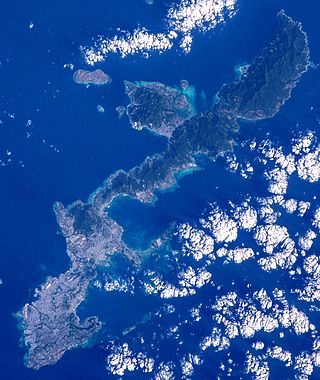
Naval Base Okinawa, now Naval Facility Okinawa, is a number of bases built after the Battle of Okinawa by United States Navy on Okinawa Island, Japan. The naval bases were built to support the landings on Okinawa on April 1, 1945, and the troops fighting on Okinawa. The Navy repaired and did expansion of the airfields on Okinawa. United States Navy Seabees built or repaired the facilities on the island. The bases on Okinawa put the United States Armed Forces only 350 miles from Japan's home islands. Most facilities closed after the war, but some are still in use today by all branches of the United States Armed Forces.

Naval Base Brisbane was a major United States Navy base built in the early part of World War II at Brisbane, Queensland, Australia. At first, operated as a base for patrol aircraft and convoy escort aircraft to protect the last leg of the Pacific War to the Southwest Pacific. As the US Navy expanded in the island hopping campaign, Naval Base Brisbane expanded to include a submarine base, repair depot, seaplane base and other facilities. US Navy operations started on April 14, 1942, and ended after the war in 1945.

Naval Base Woodlark Island was a United States Navy base built during World War II on Woodlark Island on Papua New Guinea. The US Navy built a PT boat base, boat repair depot, and harbor facilities at the city of Guasopa to support the Pacific War in 1943. The Harbor facilities was also built to support the US Navy in building the Narewa Airfield on the island. The base was part of the New Guinea campaign.
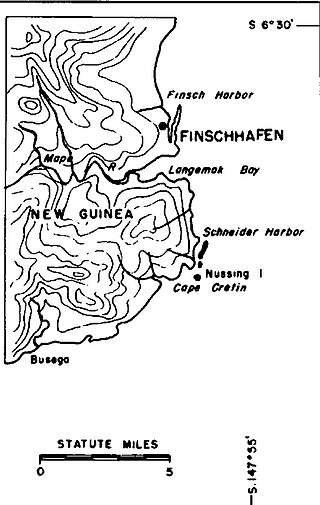
Naval Base Finschhafen was a United States Navy base built during World War II at Finschhafen on the Huon Peninsula in Morobe Province of Papua New Guinea. The US Navy built a PT boat base, Dreger Harbor PT Boat Base, boat repair depot, and harbor facilities at Dreger Harbour and Langemak Bay to support the Pacific War in 1943. Harbor was also built to support the US Navy in building 6,000-foot Finschafen Airfield, also called Dreger Field, now Finschhafen Airport on the island. The base was part of the New Guinea campaign.

Naval Base Puerto Princesa, Naval Base Palawan, was a United States Navy base built during World War II at Puerto Princesa on Palawan Island, Philippines, after the Invasion of Palawan on February 28, 1945. Puerto Princesa Bay offered an excellent base for fleet anchorage. At the naval base, US Navy Seabees built: a seaplane base, carrier aircraft fighter plane repair depot, land airfield and other base facilities.
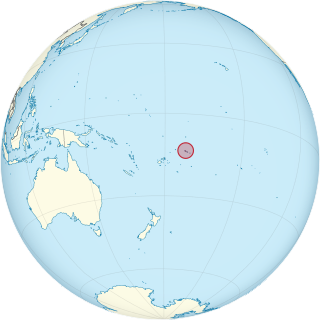
Naval Base Upolu was a naval base built by the United States Navy in 1942 to support the World War II effort. The base was located on Upolu Island, Samoa in the Western Pacific Ocean, part of the Samoan Islands's Naval Base Samoa. After the surprise attack on Naval Station Pearl Harbor on December 7, 1941, the US Navy was in need of setting up more advance bases in the Pacific Ocean. At Naval Base Upolu the Navy built a sea port, an airbase and a seaplane base.

Naval Base Funafuti was a naval base built by the United States Navy in 1942 to support the World War II effort. The base was located on the Island of Funafuti of the Ellice Islands in the Western Pacific Ocean. The island is now Tuvalu, an island country in the Polynesian. After the surprise attack on Naval Station Pearl Harbor on December 7, 1941, the US Navy was in need of setting up more advance bases in the Pacific Ocean. At Naval Base Funafuti the Navy built a sea port, a small hospital, PT boat base, a seaplane base and an airbase. The United States Marine Corps landed on Funafuti on 2 October 1942 and on Nanumea and Nukufetau in August 1943. The Japanese had already occupied Tarawa and other islands in what is now Kiribati, but were delayed by the losses at the Battle of the Coral Sea.
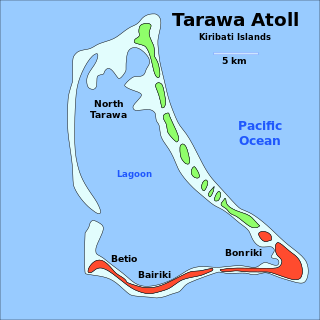
Naval Base Tarawa was a naval base built by the United States Navy in 1943 to support the World War II effort. The base was located on Tarawa atoll in the Gilbert Islands in the Central Pacific Ocean. The base was built as one of many advance bases in the island-hopping campaign towards the Empire of Japan. At Naval Base Tarawa the Navy built a seaport, seaplane base and two airbases. Construction started after the Battle of Tarawa ended November 23, 1943, part of Operation Galvanic.

Naval Base Fiji was a naval base built by the United States Navy in 1942 to support the World War II effort. The base was located on Fiji in the Central Pacific Ocean. The base was built as one of many advance bases in the island-hopping campaign towards the Empire of Japan. The US Navy built seaports, seaplane bases and airfields used for staging in the Pacific War.

U.S. Naval Base Australia comprised several United States Navy bases in Australia during World War II. Australia entered World War II on 3 September 1939, being a self-governing nation within the British Empire. The United States formally entered the war on 7 December 1941 after the Japanese attack on Pearl Harbor. Following this attack Japanese forces quickly took over much of the western and central Pacific Ocean. The United States lost key naval bases including Naval Base Manila and Naval Base Subic Bay as a result of the 1941 Japanese invasion of the Philippines, along with Guam and Wake Island. The Allied forces needed new bases in the South West Pacific to stage attacks on Japan's southern empire, and these were built in Australia.
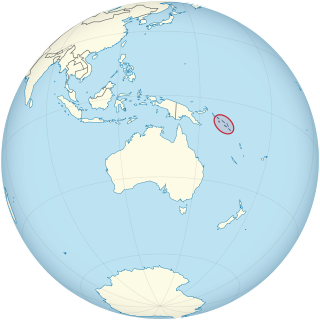
US Naval Base Solomons was a number of United States Navy bases in the Solomon Islands in the Pacific Ocean. Most were built by the US Navy Seabees, Naval Construction Battalions, during World War II as part of the Pacific War. In August 1942 the United States Armed Forces took the Guadalcanal in the Solomon, in the Battle of Guadalcanal. US Navy Seabees built a new base at Guadalcanal, Naval Base Guadalcanal and then on other islands in the Solomons.

Naval Base Hawaii was a number of United States Navy bases in the Territory of Hawaii during World War II. At the start of the war, much of the Hawaiian Islands was converted from tourism to a United States Armed Forces base. With the loss of US Naval Base Philippines in Philippines campaign of 1941 and 1942, Hawaii became the US Navy's main base for the early part of the island-hopping Pacific War against Empire of Japan. Naval Station Pearl Harbor was founded in 1899 with the annexation of Hawaii.
